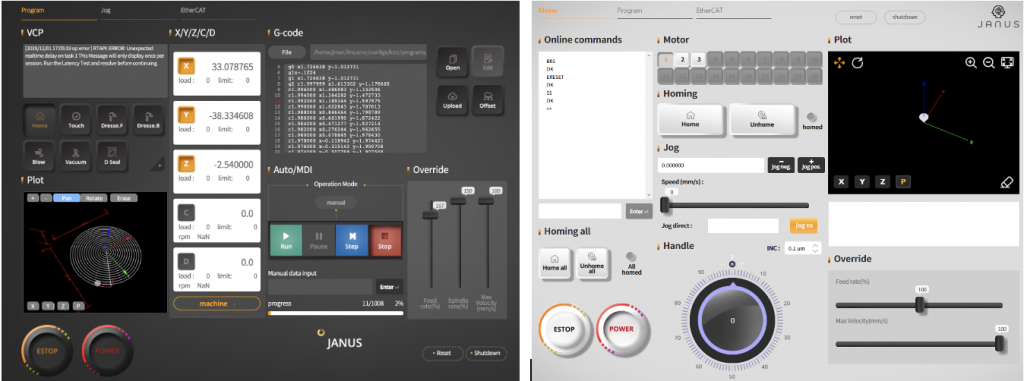Mechanical informatics refers to the information technologies to achieve efficiency, effectiveness, and reliability in the mechanical environment. The mechanical informatics researches in SS lab have been conducted focusing on the automation and motion control systems.
Major areas include:
- System software for networked motor drive: real-time kernel, drive task design and analysis, and EtherCAT communication support.
- Motion controller software
- Model-based software development for satellite systems
- Web-based Industrial HMI (Human Machine Interface)
- ROS (robot operating system) and simulation
- OPC Unified Architecture and gateway
Current Projects:
- ” 디스플레이 제조 물류혁신을 위한 다중 이동식 자석 구동(MMMD) 제어 기술적용 위치반복 정밀도 2um급 무선 캐리어 모듈 개발”, 산업통상자원부, 2023.04 ~
Janus – multi-purpose motion controller software
Janus is an integrated system software for precision motion programming and real-time control. It supports both RS-272 (g-code) and PMAC programming systems. Based on the EtherCAT and real-time kernel (RTAI or Xenomai) technologies, the software-based motion controller can perform feedback control over servo drives only with a few us of jitter at 10kHz frequency. For CNC applications, it includes g-code interpreter, real-time motion planning with look-ahead, and ladder-based PLC. And, for general motion applications, it has PMAC interpreter and online command shell. The enhanced HAL (Hardware Abstraction Layer) architecture guarantees hard real-time performance and facilitates adding new device and communication support.

EtherCAT motor drive software
In cooperation with Prof. T. Kim (U. of Seoul) and Prof. K. Kim (Soongsil U.)
For the development of a precision motor drive, we have to cope with challenges in software design: “how to bound the end-to-end delay from message release to motor actuation” and “how to integrate all the control loops so that responsiveness is maximized”. Our main contributions are (a) restructuring of drive software into a multi-task model, (b) period synthesis for minimized cycle time, and (c) stochastic analysis of end-to-end delay.

For flexibility and better analyzability, a proprietary real-time kernel has been developed to realize a multi-tasked software in the resource-constrained drive hardware, i.e., with a DSP of 60 MIPS and 128 KB of memory.  The kernel has only 7KB of memory footprint and 3 us of interrupt latency. Based on this, the legacy big-loop style drive software has been restructured into a multi-tasked one and EtherCAT slave function has been added. For minimized controller cycle, task periods have been synthesized. Using stochastic response time analysis, we could successfully find the task periods that maximize the processor utilisation while the deadline miss probabilities are less than the given thresholds. The developed software is currently in use in a commercial servo drive.
The kernel has only 7KB of memory footprint and 3 us of interrupt latency. Based on this, the legacy big-loop style drive software has been restructured into a multi-tasked one and EtherCAT slave function has been added. For minimized controller cycle, task periods have been synthesized. Using stochastic response time analysis, we could successfully find the task periods that maximize the processor utilisation while the deadline miss probabilities are less than the given thresholds. The developed software is currently in use in a commercial servo drive.
PLCopen OPC Unified Architecture
OPC Unified Architecture (UA) is a communication technology for secure, reliable and interoperable transport of information in control and automation environment. PLCopen OPC UA maps the IEC 61131-3 software model to the OPC UA information model. Based on the Beremiz PLC framework, the PLCopen OPC UA functions are implemented and evaluated.

EtherCAT PLC
In cooperation with Prof. T. Kim (U. of Seoul)
EtherCAT, a real-time Ethernet for industrial communication is gaining attraction in various automation applications. For precision motion control, EtherCAT-based PLC offers tremendous advantages over traditional analog-link-based centralised systems.

For our study, a software-based EtherCAT PLC has been developed solely using open source software solutions: Xenomai-patched Linux, IgH EtherCAT protocol stack, and Beremiz. This facilitates a highly synchronized control process, whereby the Xenomai kernel significantly reduces the deviation of controller delay, while EtherCAT enhances the predictability of the message and clock events through its almost deterministic message relaying and precisely synchronized clock.
 In Beremiz, we implemented the EtherCAT plugin and integrated the EtherCAT stack via the plugin interface. The plugin is mainly composed of two types of classes, each representing the profiles of the controller and slave devices. We also implemented a C wrapper API to the EtherCAT stack. The class definitions together with the EtherCAT API are used by the IEC compiler for the generation of runtime codes. When a new program has been configured to use EtherCAT, the plugin support module imports information on the slave profile and the EtherCAT API from the plugin definition. Using a realistic motion control workload, the performance of the developed system has been extensively evaluated. It was seen that the controller could successfully operate tens of drives in position or velocity mode with a cycle time of 0.5 ms. The supported hardware includes Freescale i.MX6 and Altera Cyclone V as well as industrial PC.
In Beremiz, we implemented the EtherCAT plugin and integrated the EtherCAT stack via the plugin interface. The plugin is mainly composed of two types of classes, each representing the profiles of the controller and slave devices. We also implemented a C wrapper API to the EtherCAT stack. The class definitions together with the EtherCAT API are used by the IEC compiler for the generation of runtime codes. When a new program has been configured to use EtherCAT, the plugin support module imports information on the slave profile and the EtherCAT API from the plugin definition. Using a realistic motion control workload, the performance of the developed system has been extensively evaluated. It was seen that the controller could successfully operate tens of drives in position or velocity mode with a cycle time of 0.5 ms. The supported hardware includes Freescale i.MX6 and Altera Cyclone V as well as industrial PC.
